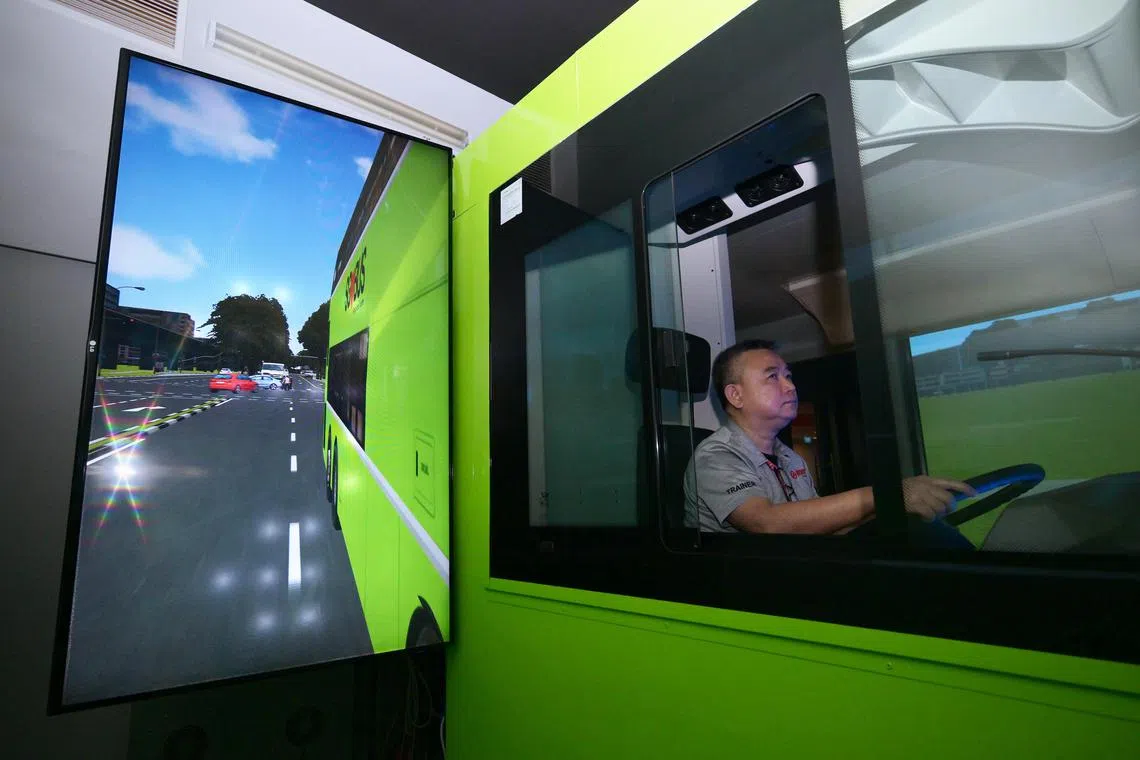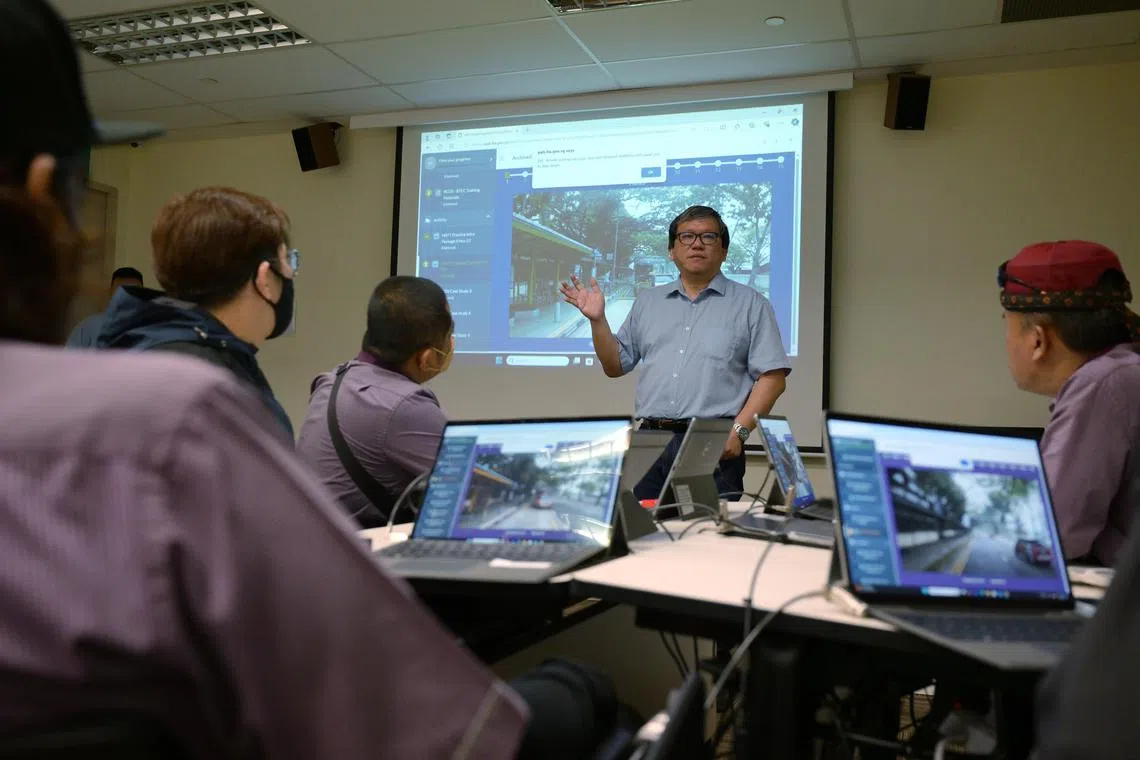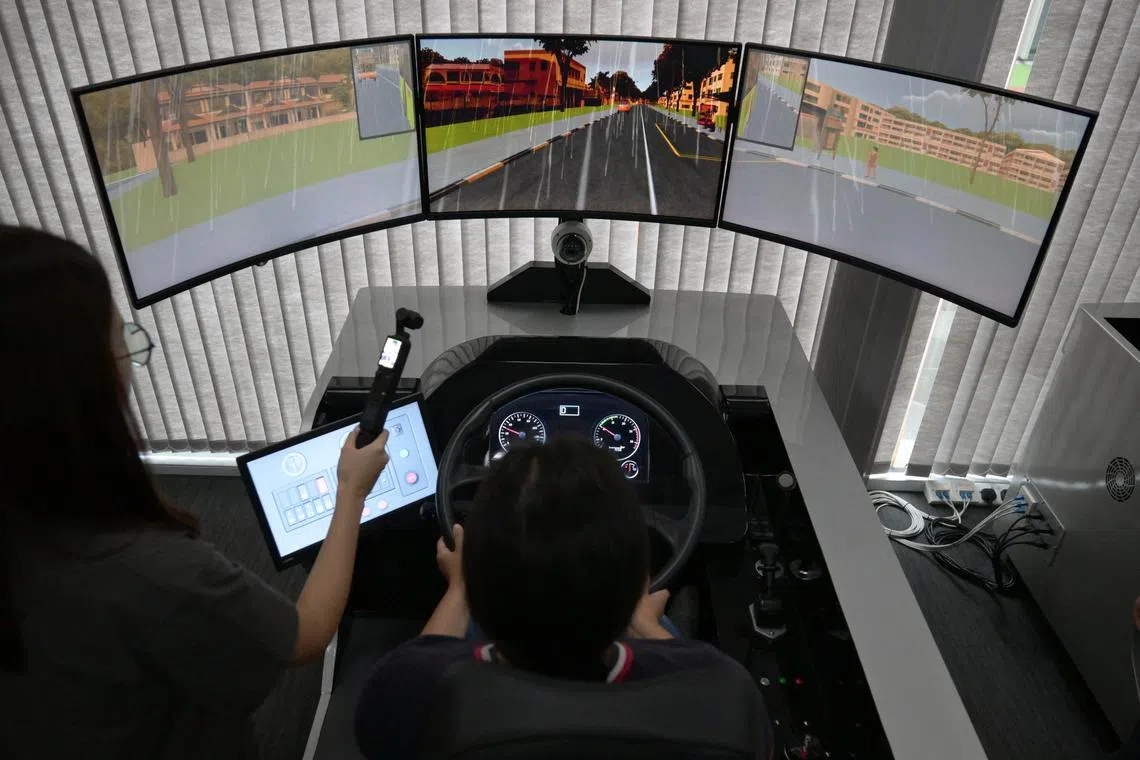4 in 10 bus drivers in Singapore have completed safe driving refresher course, with rest to follow
Sign up now: Get ST's newsletters delivered to your inbox

The course’s aim is to teach public bus drivers to recognise and respond to dangerous situations they may encounter.
ST PHOTO: NG SOR LUAN
Follow topic:
SINGAPORE – After doing a refresher course on safe driving on Feb 5, bus captain Mohammad Fahmi Yahaya’s takeaway was to be more patient on the road.
“If you lose your patience, you start to do things that may not be very safe,” the bus driver of seven years told The Straits Times.
Mr Fahmi, 47, drives bus service 70 from Yio Chu Kang Interchange to Shenton Way. The route is operated by public transport operator SBS Transit (SBST).
The course’s aim is to teach public bus drivers to recognise and respond to dangerous situations they may encounter. They also get the opportunity to practise this type of response in a simulator.
Mr Fahmi said the course reinforced the importance of “all the safety that we have to know every day”.
“It really wake up my idea!” Mr Fahmi said of the one-day course, using a colloquial phrase meaning “to realise the importance of something”.
He is among more than 4,000 bus drivers who have completed the refresher course since it was launched in August 2022. As at December 2024, about 40 per cent of all bus drivers here have completed the course, the Land Transport Authority (LTA) told ST.
There are around 9,500 public bus drivers in Singapore.
The Singapore Bus Academy (SGBA) will work with public transport operators SBST, SMRT Buses, Tower Transit Singapore (TTS) and Go-Ahead Singapore (GAS) to arrange for all bus drivers to attend the course in the coming months, LTA said.
SGBA was set up by LTA in 2016 as a centralised academy to provide training programmes for the bus industry.
While the refresher course, known as BC Drive Safe, is not currently compulsory, LTA said the aim is for all bus drivers to attend. The course is focused on fostering a safe driving culture.

In the hands-on segment of the refresher course, drivers have about four hours to practise in simulators.
ST PHOTO: NG SOR LUAN
The media was invited to SGBA to attend the course, which runs thrice a week, earlier in February.
This comes as a task force – formed on July 1, 2024,
The group, led by Minister of State for Transport Murali Pillai, was formed following a spate of accidents involving public buses.
LTA noted on Feb 7 that the number of serious collisions each year involving public buses in Singapore has remained stable in the past few years.
There were 185 serious collisions in 2024, compared with 200 in 2023 and 191 in 2022.
ST attended the refresher course alongside 14 bus drivers from the four public bus operators.
Some drivers in each class have less driving experience, while others have more years of driving a bus under their belt. Their driving records are different too, LTA said, and classes are kept small – between 15 and 20 drivers at a time – to encourage discussion.

Classes are kept small to encourage discussion.
ST PHOTO: NG SOR LUAN
The course begins with two hours allocated to hazard awareness training and testing.
Using real dashcam footage of accidents or near-misses on Singapore roads, drivers are taught to recognise potentially dangerous situations and how to respond to them appropriately.
In the next two hours, drivers discuss case studies in small groups of four or five.
The case studies are also based on actual accidents involving public buses. Drivers then present their findings – such as what caused the accident and how it could have been avoided – to the rest of the class.
In the hands-on segment of the course, drivers have about four hours to practise in simulators. SGBA has 18 bus simulators, including eight full cabin simulators that replicate the driver’s console, instrument panel and driving characteristics of various types of buses.
ST observed a lively exchange of ideas among the attendees during the course.

Drivers discussing case studies in small groups of four or five.
ST PHOTO: NG SOR LUAN
When asked what he most enjoyed about it, Mr Fahmi said it was good to mix with drivers from other operators. “We can share knowledge. We have different encounters on the roads, because we are from different companies and ply different routes,” he added.
About half of SBST’s 5,400 bus drivers have taken part in the course, with the remainder scheduled to attend by the end of the year. The operator said that a good safety record is essential for career progression.
SMRT Buses said more than 1,000 of its drivers – out of over 2,000 – have attended the course.
“Our goal is to have all our bus captains complete the course by the end of 2025,” said Mr Vincent Gay, deputy managing director of SMRT Buses.
Most of TTS’ drivers have taken part in the course, with more than 1,000 of its 1,450 drivers having attended it.

While the refresher course is not currently compulsory, LTA said the aim is for all bus drivers to attend.
ST PHOTO: NG SOR LUAN
Mr Glenn Lim, director of communications and customer experience, said TTS is aiming to have all its current drivers attend the course by the end of the year.
As for GAS, more than 400 of its 800-plus drivers have completed the course, said Mr Chris Tan, senior manager of human resource training.
The three bus operators said they had received positive feedback from drivers.
Mr Gay said many drivers at SMRT Buses had “found the theory lessons valuable in understanding accident trends and the root causes of bus-related road incidents”.
“The simulator training further enhanced their confidence by providing a safe environment to practise defensive driving and respond to unsafe behaviour from other road users,” he added.
In response to ST’s questions on the effectiveness of the refresher course, Mr Gay said the operator’s telematics data showed improvements in drivers’ driving performance and safety records.
Telematics is the integrated use of telecommunications and informatics to collect, transmit and analyse data, such as the position and speed of a vehicle, harsh braking, seat belt use, and vehicle faults.
Mr Lim noted that “as a general trend, bus captains’ safety scores, measured by our onboard telematics system, have seen slight improvements after the course”.
He said this was observed by comparing TTS drivers’ average safety score in the three months before attending the course and the three months after.
Vanessa Paige Chelvan is a correspondent at The Straits Times. She writes about all things transport and pens the occasional commentary.


